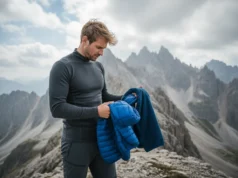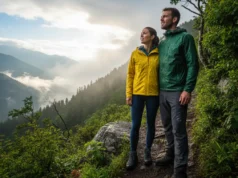In this article
Standing on an exposed ridgeline, the wind relentlessly stripping away your warmth, turning a beautiful summit push into a desperate battle to stay comfortable. This single piece of gear—the humble wind jacket, often called a windbreaker or wind shell—is often the only thing standing between an epic day and a miserable retreat. But choosing the right one is a masterclass in balancing competing demands. This guide will not just show you the best hiking wind jackets; it will teach you how to think like a gear expert, ensuring your choice is a perfect extension of your hiking style.
This guide will empower you to learn the crucial balance between wind resistance and breathability (measured in CFM) and why it’s the most important decision you’ll make. You will come to understand how weight and packability define a wind shell’s role as an essential “just-in-case” layer and one of your core packing essentials for everything from casual day hikes to demanding ultralight backpacking trips. We will help you discover our top picks for three distinct hiker types: the All-Around Day Hiker, the Fast-and-Light Mountain Athlete engaged in trail running or alpine climbing, and the Ultralight Thru-Hiker. Finally, you’ll see why materials like Pertex Quantum Air excel in high output activities while tightly woven nylon ripstop offers maximum protection against strong winds.
How to Choose the Right Hiking Wind Jacket: An Expert’s Framework
To select the right windbreaker jacket, you need to move beyond marketing claims and understand the core principles of performance fabrics. This framework will arm you with the objective knowledge needed to make a smart, confident choice that perfectly matches your needs on the trail.
Why is the Wind Resistance vs. Breathability Trade-off So Important?
The single most critical decision when you choose a wind jacket is navigating the eternal conflict between blocking wind and letting sweat escape. Get this balance of wind protection and ventilation right, and the jacket becomes an indispensable tool. Get it wrong, and you’ll be just as uncomfortable as if you had no jacket at all.
A wind jacket’s primary job is to prevent convective heat loss. As wind rushes past your body, it strips away the thin layer of warm air—your microclimate—that your body works so hard to create. A good wind shell acts as a shield, preserving that microclimate and allowing your base layers to do their job. In many cool, blustery conditions, a simple wind-resistant layer can provide as much functional warmth as a bulky fleece, making it a cornerstone of an efficient layering system.
However, a completely windproof barrier creates the dreaded “boil-in-the-bag” problem. As you hike uphill during high output activities, your body produces a tremendous amount of heat and moisture vapor. A shell with no way to breathe, like a basic rain jacket, traps all that vapor inside. Your base layers become saturated with sweat, and the moment you stop moving—like during a break in low output activities—that moisture rapidly cools, leaving you dangerously chilled and clammy.
This is where we measure a fabric’s Air Permeability in CFM, or Cubic Feet per Minute. This metric tells us how much air can pass through one square foot of the fabric in one minute. A low CFM rating, like 10 or less, signifies high wind resistance but poor breathability; it’s a fortress against the wind. A high CFM rating, above 30, means the fabric breathes exceptionally well but offers less protection in a gale. Matching the right CFM to your activity is the key. High-output pursuits like mountain running or ski touring demand a higher CFM to dump heat, while moderate-paced hiking in exposed, windy mountains requires a lower CFM for superior protection. This balance directly impacts how your entire clothing system performs, especially your base and mid-layers. Understanding this trade-off is the first step to understanding how a proper layering system works to regulate your temperature effectively.
Pro-Tip: You can get a rough feel for a jacket’s breathability in the store. Hold the fabric taut and press it against your lips. Try to blow through it. If you feel almost no air pass through, it’s a low-CFM jacket built for maximum wind resistance. If you can feel your breath pass through easily, it’s a high-CFM jacket designed for high-output activities.
How Much Durability and Weather Resistance Do You Really Need?
After dialing in breathability, you must consider how much abuse your jacket needs to handle. The trade-offs here are between weight, durability, and a minimal degree of weather resistance.
First, let’s be clear: a windbreaker vs rain jacket comparison is crucial—a wind jacket is NOT a rain jacket. Its ability to fend off weather comes almost entirely from a Durable Water Repellent (DWR) coating applied to the exterior fabric. Many modern jackets use a PFC-free DWR finish, which is a nod to better sustainability. This chemical finish causes water to bead up and roll off, making it effective against a light mist or very brief shower. It will not keep you dry in sustained rain; for that, you need a dedicated rain jacket for hiking.
The durability of that fabric is primarily determined by its denier, noted as ‘D’. This is simply a measure of the thickness of the yarn used. A 7D or 10D material is gossamer-thin, allowing for an incredibly ultralight and packable jacket (the lightest wind jacket models like the Montbell Tachyon Hooded use these), but it’s also highly susceptible to snags and tears on rugged terrain. On the other end, a 30D or 40D fabric feels much more robust and can withstand significant abrasion, but it comes with a penalty in both weight and packed size. For most hikers, a fabric between 15D and 20D strikes an excellent balance. When comparing fabrics of the same denier, nylon is typically more abrasion-resistant than polyester, making it the go-to choice for high-performance shells. Understanding these trade-offs is key to avoiding both a shredded ultralight shell after one season and a needlessly heavy, overbuilt jacket that you hesitate to even put in your pack.
Pro-Tip: Most DWR coatings wear off over time due to dirt, abrasion, and washing. You can reactivate it by washing the jacket with a technical fabric cleaner (like Nikwax Tech Wash) and then tumbling it in a dryer on low heat for about 20 minutes. This helps redistribute the DWR and can significantly restore its water-repellency.
Our Selection Process: How We Built This Guide
To build this guide, we committed to a process of absolute objectivity and transparency. Our goal was to move beyond marketing claims and deliver recommendations grounded in empirical data, technical specifications, and a synthesis of expert field tests. Every jacket was analyzed against five critical performance criteria: Wind Resistance, Breathability, Weather Resistance, Packability & Weight, and Durability & Versatility. We also considered crucial factors like fit, comfort, and mobility. We started with a market-wide analysis of over 30 top-rated windbreaker jackets. This extensive list was then curated and filtered to identify the top performers for three distinct hiker archetypes, ensuring each recommendation is a targeted solution for a specific need. We use affiliate links, which means we may earn a small commission if you make a purchase, at no extra cost to you. This helps support our independent research and testing. Our recommendations are, and always will be, driven by performance, not profit.
The Best Hiking Wind Jackets of 2025: Our Top Recommendations for Every Need
Our Top Picks for The All-Around Day Hiker
This user needs a reliable, versatile, and high-value windbreaker jacket that performs well on the trail but doesn’t look out of place in town. Practical features like zip hand pockets and a balance of performance are key for these casual hikes.
Our Top Picks for The Fast-and-Light Mountain Athlete
This user moves quickly through technical terrain like trail running or alpine climbing and generates a lot of heat. Their non-negotiable priority is maximum breathability to stay dry from the inside out during high output activities. Durability and an athletic, mobile fit are also paramount for fastpacking and mountaineering.
Conclusion
The ideal hiking wind jacket is not the most windproof, but the one that best balances wind resistance with the breathability your activity level demands. You must define your primary use case first. A Day Hiker’s need for versatility, a Mountain Athlete’s demand for breathability during high-output efforts, and a thru-hiker’s obsession with weight and packability for multi-day treks lead to vastly different “best” jackets. Always pay attention to fabric denier (e.g., 7D vs 30D) as it is the clearest indicator of the trade-off between weight and long-term durability. And remember that a wind shell is a specialized piece of hiking gear; its limited weather resistance from a DWR coating is designed for mist and brief showers, not sustained rain.
Armed with this knowledge, you’re ready to make a choice. Revisit the recommendations for your hiker type, pick the jacket that best matches your needs, and hit the trail with the confidence that you’re carrying the right tool for the job.
Frequently Asked Questions about Hiking Wind Jackets
What is the difference between a wind jacket and a rain jacket?
A wind jacket’s primary purpose is to block wind and provide high breathability, while a rain jacket’s purpose is to be completely waterproof, which makes it far less breathable. For windy but dry conditions, choose a windbreaker jacket like the Arc’teryx Squamish Hoody. For sustained rain, you need a dedicated rain jacket.
Do I really need a wind jacket if I already have a fleece and a rain shell?
Yes, a wind jacket (or wind shell) fills a critical gap in your layering system: it provides significant wind protection without the warmth of a fleece or the poor breathability of a rain shell. An ultralight wind jacket like the iconic Patagonia Houdini weighs only a few ounces and allows you to stay comfortable in a wider range of conditions without needing to add or remove heavier layers.
What does CFM mean for a wind jacket and what should I look for?
CFM stands for Cubic Feet per Minute and measures air permeability; a higher CFM means more air passes through, making the jacket more breathable but less wind resistant. For high-output activities like trail running, look for a high CFM (30+) jacket like the Mountain Hardwear Kor AirShell. For general hiking in windy places, a lower CFM (<15) provides better protection.
Is a more expensive wind jacket worth it?
Often, yes; a higher price typically gets you a more advanced material that better balances the wind resistance vs. breathability trade-off, a more refined athletic fit, and lighter weight. While a value option like the Rab Vital Hoody is excellent, a premium model like the Arc’teryx Squamish Hoody offers superior performance, better mobility, and often includes features like a helmet-compatible hood for demanding athletes.
Risk Disclaimer: Hiking, trekking, backpacking, and all related outdoor activities involve inherent risks which may result in serious injury, illness, or death. The information provided on The Hiking Tribe is for educational and informational purposes only. While we strive for accuracy, information on trails, gear, techniques, and safety is not a substitute for your own best judgment and thorough preparation. Trail conditions, weather, and other environmental factors change rapidly and may differ from what is described on this site. Always check with official sources like park services for the most current alerts and conditions. Never undertake a hike beyond your abilities and always be prepared for the unexpected. By using this website, you agree that you are solely responsible for your own safety. Any reliance you place on our content is strictly at your own risk, and you assume all liability for your actions and decisions in the outdoors. The Hiking Tribe and its authors will not be held liable for any injury, damage, or loss sustained in connection with the use of the information herein.
Affiliate Disclosure: We are a participant in the Amazon Services LLC Associates Program, an affiliate advertising program designed to provide a means for us to earn advertising fees by advertising and linking to Amazon.com. As an Amazon Associate, we earn from qualifying purchases. We also participate in other affiliate programs and may receive a commission on products purchased through our links, at no extra cost to you. Additional terms are found in the terms of service.





